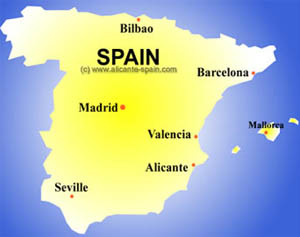Strawberry fields threaten Spain's Wild West
 El Rocio, Spain - Can this really be Spain? The Atlantic beach is deserted for as far as the eye can see and beyond that only a lonely Mercedes-Benz Unimog offroader grinds its way up a sandy incline.
El Rocio, Spain - Can this really be Spain? The Atlantic beach is deserted for as far as the eye can see and beyond that only a lonely Mercedes-Benz Unimog offroader grinds its way up a sandy incline.
There are no multi-storey hotel complexes, villas or golf courses in these parts. Sand dunes are the only topographical feature - miles of them untouched but for the hoofprints of passing deer.
Welcome to one of the last unspoilt, wilderness areas along Spain's southern coastline, the Coto de Donana National Park in Andalusia. This wildlife refuge is one of Europe's most important wetland reserves yet its future is under threat - from strawberry fields.
Donana is a patchwork of different habitats: Behind the shifting sands along the coast are pine woodlands, groves of cork trees and heathland. This is followed by boggy marshland which is regularly flooded by the sea and broken up by many lagoons. The ecological mosaic has been carved by the Guadalquivir river which deposited sand and other alluvial deposits here over thousands of years.
Donana is known for its numerous variety of bird species - an estimated six million of them. These are either permanent residents, winter visitors stopping over from north and central Europe or summer visitors from Africa.
Colourful colonies of pink flamingos stalk the shallow waters of the Laguna de Santa Olaya at the heart of the National Park alongside spoonbills and heron. There are organised off-road tours to visit the lagoon since the park is off-limits to individual tourists. They are only allowed to explore the areas near the visitor centres.
Donana has survived Spain's property boom and various plantation projects thanks to the Worldwide Fund for Nature (WWF). The independent conservation organisation has campaigned down the years for the privately-owned coastal stretch and marshy hinterland to be placed under protection. Their efforts were finally rewarded nearly 40 years ago in October 1969. Not that the environmentalists are content to sit back and pat each other on the back.
"Illegal boreholes have led to the level of the Rocina dropping by around half over the past 30 years," said Felipe Fuentelsaz from the Spanish arm of the WWF.
The Rocina is the most important river in the Donanas. It used to remain in flow until early summer and was known as the "mother of the marsh," but in recent years the waterway has been dried-up by June. This is mainly because its waters are syphoned off for the strawberry plantations whose products are sold from supermarket shelves across northern Europe.
Fuentelsaz and a number of his colleagues have been trying to counter this water wastage, showing local farmers how to conserve water and still harvest the fat, juicy strawberries they want by using modern agricultural techniques.
They have so far managed to save a quarter of the water normally used for irrigation through using sprinklers and moisture sensors in the ground. The technology is linked to a computer which runs the system automatically. These "green" strawberries are sold under the WWF's panda brand at a slight premium which it seems customers are willing to pay.
A little further down the river from "La Rocina" is the hamlet of El Rocio. With its unpaved streets, wide sandy squares and white houses fronted by verandas where horses can be tethered, El Rocio seems like the perfect place to make a western film - the atmosphere here is of a bygone age.
The town is home to around 1,000 souls and only comes to life once a year at Whitsun when the annual pilgrimage to the El Rocio shrine attracts a million people from across Andalusia, Spain and beyond. People flock to pay tribute to the El Rocio Virgin, or Madonna of the Dew, which is brought out for display and veneration for the occasion.
The animal celebrities of the Donana region are meanwhile to be found in El Acebuche. "We are trying to get the lynx classed as an endangered species," biologist Astrid Vargas tells visitors. The lynx is classed as "seriously endangered" and according to experts, there are just 45 adult female lynx at large throughout Spain and Portugal.
Tourists can see live footage of these rare cats flickering on the flat screen television in the foyer of the visitor centre. The breeding programme complex shown here is kept from prying eyes. Located in a remote bushland corner, it is surrounded by several rings of impenetrable fencing.
Human contact with the lynx is deliberately restricted so that once returned to the wild the animals do not come purring around human settlements when their food runs out. Since 2005 the project has seen the birth of 24 baby lynx yet biologist Vargas says "the breeding programme is definitely not the way to prevent the lynx from becoming extinct" and adds: "We must focus our attention on ensuring that their habitat remains intact."
And that brings visitors back to the strawberries. Whole swathes of woodland have been illegally felled for plantations and the rows of makeshift greenhouses with their sterile, plastic-film membranes have turned many of the trails used by wildlife here into cul-de-sacs. Donana is gradually becoming a land-bound "island." Fewer animals are able to wander into the area and bring with them fresh blood. The result is that the otter and the lynx are suffering a gene pool deficiency which may eventually diminish their chances of survival.
Internet: http://whc.unesco.org/en/list/685, www.turismodedonana.com, http://reddeparquesnacionales.mma.es, http://www.andalucia.com/festival/rocio.htm (dpa)